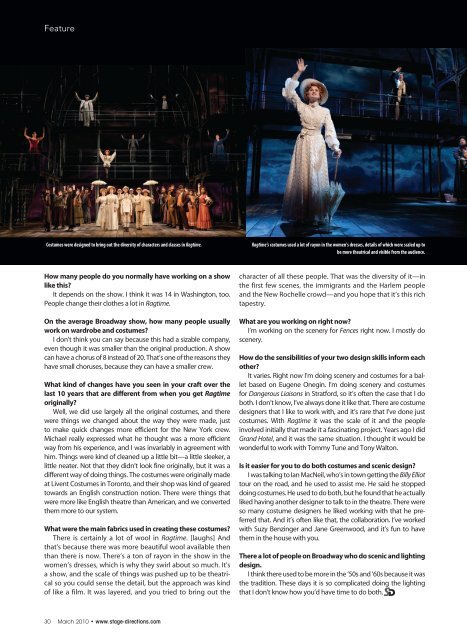Download a PDF - Stage Directions Magazine
Download a PDF - Stage Directions Magazine
Download a PDF - Stage Directions Magazine
Create successful ePaper yourself
Turn your PDF publications into a flip-book with our unique Google optimized e-Paper software.
Feature<br />
Costumes were designed to bring out the diversity of characters and classes in Ragtime.<br />
Ragtime’s costumes used a lot of rayon in the women’s dresses, details of which were scaled up to<br />
be more theatrical and visible from the audience.<br />
How many people do you normally have working on a show<br />
like this?<br />
It depends on the show. I think it was 14 in Washington, too.<br />
People change their clothes a lot in Ragtime.<br />
On the average Broadway show, how many people usually<br />
work on wardrobe and costumes?<br />
I don’t think you can say because this had a sizable company,<br />
even though it was smaller than the original production. A show<br />
can have a chorus of 8 instead of 20. That’s one of the reasons they<br />
have small choruses, because they can have a smaller crew.<br />
What kind of changes have you seen in your craft over the<br />
last 10 years that are different from when you get Ragtime<br />
originally?<br />
Well, we did use largely all the original costumes, and there<br />
were things we changed about the way they were made, just<br />
to make quick changes more efficient for the New York crew.<br />
Michael really expressed what he thought was a more efficient<br />
way from his experience, and I was invariably in agreement with<br />
him. Things were kind of cleaned up a little bit—a little sleeker, a<br />
little neater. Not that they didn’t look fine originally, but it was a<br />
different way of doing things. The costumes were originally made<br />
at Livent Costumes in Toronto, and their shop was kind of geared<br />
towards an English construction notion. There were things that<br />
were more like English theatre than American, and we converted<br />
them more to our system.<br />
What were the main fabrics used in creating these costumes?<br />
There is certainly a lot of wool in Ragtime. [laughs] And<br />
that's because there was more beautiful wool available then<br />
than there is now. There’s a ton of rayon in the show in the<br />
women’s dresses, which is why they swirl about so much. It’s<br />
a show, and the scale of things was pushed up to be theatrical<br />
so you could sense the detail, but the approach was kind<br />
of like a film. It was layered, and you tried to bring out the<br />
character of all these people. That was the diversity of it—in<br />
the first few scenes, the immigrants and the Harlem people<br />
and the New Rochelle crowd—and you hope that it’s this rich<br />
tapestry.<br />
What are you working on right now?<br />
I’m working on the scenery for Fences right now. I mostly do<br />
scenery.<br />
How do the sensibilities of your two design skills inform each<br />
other?<br />
It varies. Right now I’m doing scenery and costumes for a ballet<br />
based on Eugene Onegin. I’m doing scenery and costumes<br />
for Dangerous Liaisons in Stratford, so it’s often the case that I do<br />
both. I don’t know, I’ve always done it like that. There are costume<br />
designers that I like to work with, and it’s rare that I’ve done just<br />
costumes. With Ragtime it was the scale of it and the people<br />
involved initially that made it a fascinating project. Years ago I did<br />
Grand Hotel, and it was the same situation. I thought it would be<br />
wonderful to work with Tommy Tune and Tony Walton.<br />
Is it easier for you to do both costumes and scenic design?<br />
I was talking to Ian MacNeil, who’s in town getting the Billy Elliot<br />
tour on the road, and he used to assist me. He said he stopped<br />
doing costumes. He used to do both, but he found that he actually<br />
liked having another designer to talk to in the theatre. There were<br />
so many costume designers he liked working with that he preferred<br />
that. And it’s often like that, the collaboration. I’ve worked<br />
with Suzy Benzinger and Jane Greenwood, and it’s fun to have<br />
them in the house with you.<br />
There a lot of people on Broadway who do scenic and lighting<br />
design.<br />
I think there used to be more in the ‘50s and ‘60s because it was<br />
the tradition. These days it is so complicated doing the lighting<br />
that I don’t know how you’d have time to do both.<br />
30 March 2010 • www.stage-directions.com

















